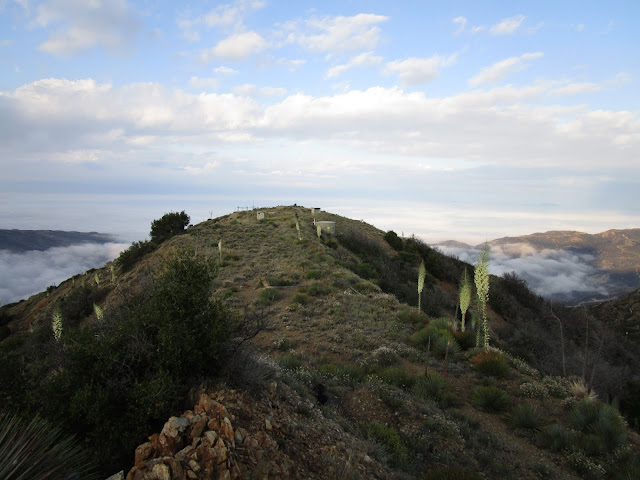Hiked: 6/26/2015
Distance: 9.2 miles round trip on trail
Summit Elevation: 9648' (Pine #1), 9575' (Dawson), 10064' (3067m, Mt. San Antonio), 9988' (West Baldy)
Prominence: 848' (Pine #1), 424' (Dawson), 6224' (Mt. San Antonio)
Elevation Gain: 4725'
Elevation Gain (in Empire State Buildings): 3.78
Round trip time: 6 hours 45 minutes
Recommended water: 168 oz.
Parking/Fees: Adventure Pass
Difficulty: Strenuous
The north backbone is a less frequently used route to climb Mt. San Antonio (Baldy). The ridge is a high altitude roller coaster starting on Blue Ridge Road and running over Pine Mountain #1 and Dawson Peak, each towering over 9000'. The northern slopes usually retain snow late into the year, but since there wasn't much snow this winter, the route was clear. The gate past Guffy Campground was open so we drove to the trailhead at a small turnout below Wright Mountain. The weather was perfect. While it was scorching at sea level, it was pleasant in the high country. The north backbone trail starts by dropping a short distance to a saddle, then climbing up to the first bump along Pine Mountain #1 ridge. Beyond the first bump is the more difficult section of Pine ridge. It is loose with tiny scree and a few class 2 sections where both sides of the ridge drop away more than 500'. However, the trail is in good shape and the danger is low unless you are careless. The mountain itself is almost completely covered with pines, ranging in age from new to ancient. There were a couple of bighorns hanging out on an adjacent ridge. When we arrived at the Pine summit, we got a good view of the rest of the backbone. Dawson hovered on the left and Mt. San Antonio blocked out the north, dwarfing the normally imposing Iron Mountain #1 (8007'). There were great views of everything within 50 miles. I could even make out the white dome of the Mt. Wilson observatory.
We descended Pine and started up the Dawson ridge. As we passed over the top of Dawson, we spotted a second, larger group of bighorns. We got a couple of photos before they bolted down the southwest side. Dawson was also covered mostly in pine trees. I think the high back country is the nicest part of the range. We took a short break on Dawson Peak before gearing up for the third segment up Mt. San Antonio. From the north, you get a better sense of the incredible size of Baldy. We started down Dawson and cached some water in a hollow log. The drop down to the Dawson-Baldy saddle is about 700', followed by a 1200' climb in just over a half mile with practically no shade. The elevation and early morning kept the heat in check. On the summit, one group was hanging out in a wind break, and soon other singles and groups made their weary way to the top. Sean decided to skip West Baldy, but I had never made the side trip so I dropped my pack and took off. I brought binoculars to look around for the plane wreck from West Baldy, but left them in my pack. There were no official marks or register on West Baldy, but I got a different perspective and a great view down Cattle Canyon. Then I returned to Baldy and we hung out on the summit for about 45 minutes before heading back.
West Baldy 360
Unlike the other three main routes to Mt. San Antonio that approach from the south, the north backbone exacts a price on the return trip, about 1400' of gain. As we got to the Dawson-Baldy saddle, we met the first group of people that were not on the Baldy summit. Three hikers were on their way up the north backbone, having started a couple of hours after us. Sean had met one of them before. We chatted about the trail and other adventures for a while before wishing them well and moving along. We picked up our water cache on Dawson, finished that climb, then continued the roller coaster up the south side of Pine. The final challenge was surfing the scree down the north side of Pine. Though difficult to reach, the remoteness and unmatched views make this my favorite route up Mt. San Antonio.


















































